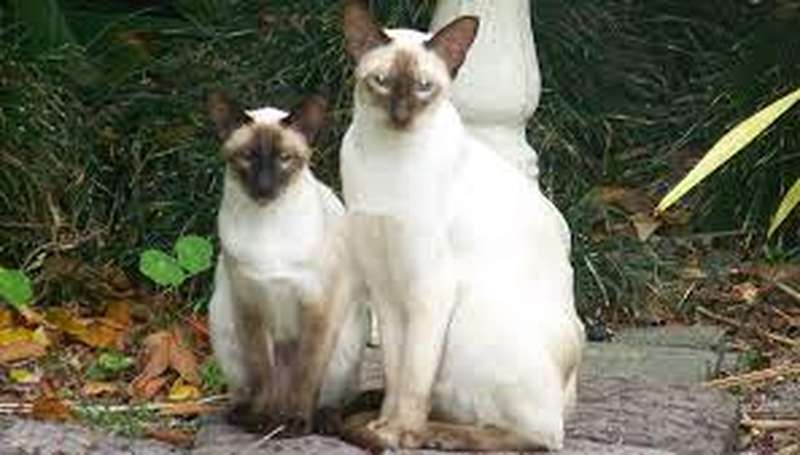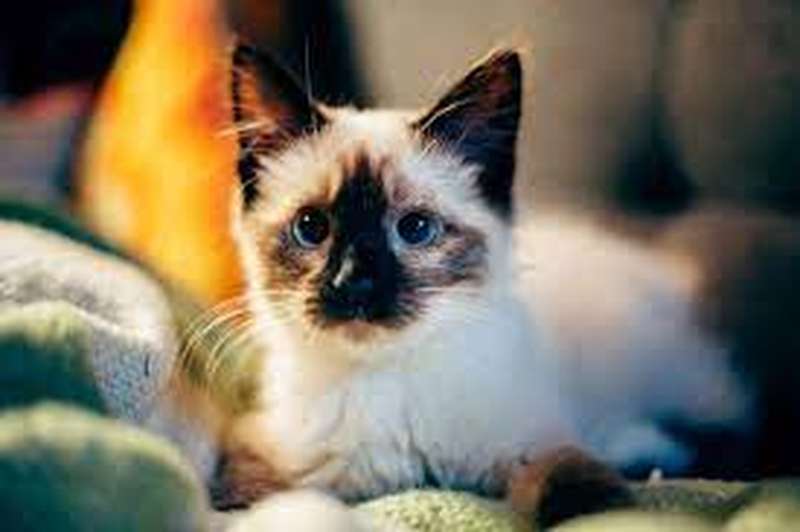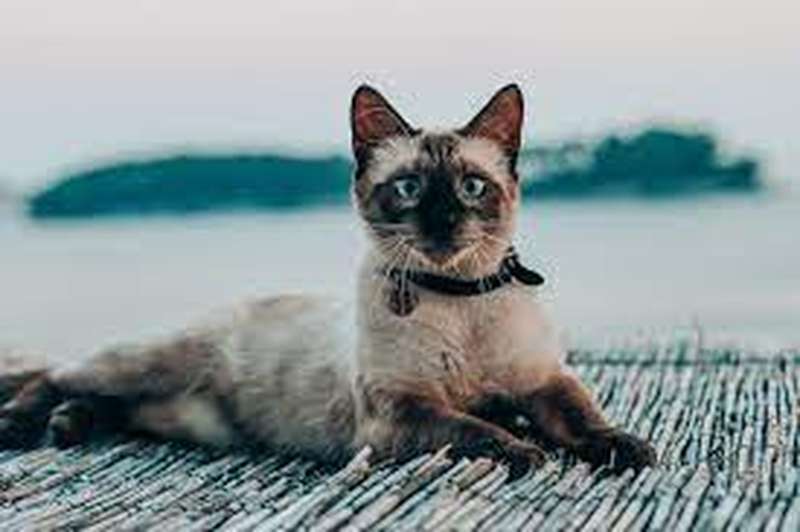The Siamese cat’s intelligence, beauty, and charm never fail to captivate. These cats behave like dogs and love attention. They crave human love.
Siamese Cat Overview
| OFFICIAL NAME | Siamese |
| COMMON NAME | Siamese |
| PET HEIGHT | 8 to 10 inches |
| PET WEIGHT | 6 to 14 pounds |
| LIFESPAN | 15 to 20 years |
| GOOD WITH | children, dogs, families, seniors |
| TEMPERAMENT | affectionate, bold, neurotic, sociable |
| INTELLIGENCE | high |
| SHEDDING AMOUNT | infrequent |
| PLAYFULNESS | high |
| ENERGY LEVEL | active |
| VOCAL LEVEL | howler |
| COAT LENGTH | short |
| COLORS | black / ebony, blue/gray, chocolate / brown/sable, cinnamon, cream/beige/tan, fawn, lavender/silver, lilac, white |
| PATTERNS | color point |
| OTHER TRAITS | High levels of territoriality, a high risk of weight gain, hypoallergenic, strong loyalty inclinations, friendliness toward humans, ease of grooming and training, good lap cat, and tolerance of being lifted up |
Appearance
Siamese cats possess a slender and elongated physique, characterized by slim yet well-developed musculature. He is instantly recognizable due to his long, thin limbs and tails, as well as his high-contrast colorpoint pattern. The colorpoint coats of these cats create a mysterious illusion, as their fur near the face, ears, legs, and tail is darkened, resembling a masquerade.

Due to their genetic makeup, this particular breed will consistently possess piercing blue eyes, which can occasionally have a slight cross-eyed appearance, enhancing their remarkable and graceful look. Siamese cats can be a suitable choice for individuals with allergies due to their short, light coat that minimizes shedding.
While you may envision a Siamese cat as being cream with dark color points, it is important to note that there are actually four different color combinations that these cats can have.
These include seal point, which features a fawn or cream body with dark seal colorpoints, chocolate point, which showcases an ivory body with dark brown colorpoints, blue point, which ranges from light silver bodies to a dark, grayish-blue colorpoint, and lilac point, which displays light cream bodies with a pinkish-gray colorpoint.
All of them are incredibly beautiful, making it tempting to adopt one of each!
Temperament
The Siamese cat is known for its friendly, affectionate, outgoing, and social personality. This breed is not only beautiful but also highly intelligent. The Siamese cat is known for its loving and trusting nature towards humans. They truly thrive when they receive plenty of positive human interaction.
He is also highly sensitive and tends to be affected by harsh words. It’s crucial to employ positive reinforcement when training your pet. This applies to teaching them to use the litter box and also to discourage them from using your couch as a scratching toy.
According to Kirsten Kranz, the director of Specialty Purebred Cat Rescue, Siamese cats are often referred to as “Velcro kitties” due to their strong affection for their owners.
These cats have a deep attachment and will frequently stay close to their owners, following them from one room to another in hopes of receiving attention and cuddles.

These cats love to cuddle and be held because they have a strong affection for their humans. While Siamese cats do appreciate having their own space at times, they often prefer to be in close proximity to their owners rather than being right on top of them.
Siamese cats are known for being conversationalists, often meowing loudly to communicate with their owners. However, it is important to note that while every cat is unique, not all of them are talkative. According to Kranz, Siamese cats can be quite vocal, although this is not the case for the majority of them.
Those individuals who possess this trait tend to be very talkative, making it seem as if they could talk endlessly. However, it is important to note that this characteristic is only present in approximately 25 percent of the breed. The remaining individuals are either moderately talkative or not talkative at all.
A Siamese cat may designate one member of the household as “his person” and develop a stronger bond with them compared to others. A prime example of this is the relationship between Patti Randall (played by Hayley Mills) and D.C., the Siamese in the Disney film “That Darn Cat!” from 1965.
However, as long as this breed receives ample affection from everyone, they will happily snuggle up with any member of the family.
Care
Due to their short, nonshedding coat, these cats require minimal grooming. A typical Siamese cat only requires weekly combing, regular ear cleaning, and nail trimming. Feel free to stroke your cat’s fur playfully. After all, he loves to be pampered and receive attention.
Although he may require minimal grooming, it is important to ensure that he has sufficient opportunities for play and exercise. Make sure to stock up on a variety of interactive cat toys, cat trees, and other enjoyable gifts for your feline friends. Make sure to schedule daily play time as well.
Siamese cats are easy to train due to their large brains. However, it should be noted that their intelligence does not guarantee their ability to be taught anything, as it is often accompanied by a strong sense of stubbornness.
They have a desire to make you happy, but they have a preference for doing things in their own way and on their own terms.
To help prevent obesity, it is important to feed your Siamese cat high-quality cat food and closely monitor their food intake. Siamese cats are prone to obesity, so taking these measures can be beneficial for their health.
It is important to consult with your veterinarian to determine the appropriate amount and frequency of feeding for your specific cat.
Siamese Health Problems
Siamese cats have an impressive lifespan, with an average of 15 years but they are also known to live well into their 20s. Considering the susceptibility of Siamese kittens to certain health conditions, it is advisable to contemplate the acquisition of pet insurance for your furry companion.
Pica
Pica in cats refers to the inclination to consume non-food items, which could potentially be a manifestation of compulsive behavior. A study published in the Journal of Veterinary Behavior found that certain oriental cat breeds, like the Siamese, are more likely to develop pica, specifically wool-sucking behavior.
Ingesting hair ties and strings is a common occurrence that can have serious consequences. If your cat ingests something inappropriate or experiences a loss of appetite for their regular meals, it is advisable to consult with your veterinarian. Consuming non-food items can lead to poisoning or internal obstructions, posing a serious threat to one’s life.
Asthma
Similar to human asthma, cat asthma is characterized by symptoms such as coughing, breathing difficulties, and wheezing. In order to alleviate symptoms for certain cats, it can be helpful to minimize dust, dander, and the use of candles, as well as opting for special cat litter.
However, it’s important to note that cats with severe feline asthma may need additional treatment such as an inhaler or lifelong oral medications.

Amyloidosis
Amyloidosis is a term used to describe a collection of diseases that occur when the fibrous protein amyloid builds up abnormally in different tissues throughout the body. Amyloidosis can disrupt the normal functions of various areas in the body, potentially resulting in conditions like liver failure and kidney disease.
Siamese cats are thought to possess a genetic mutation that makes them more susceptible to amyloidosis.
Gene-related Retinal Degeneration
Although genetic degeneration of the retina is more commonly reported in Abyssinian and Somali cats, Siamese cats may also be susceptible to this condition. Symptoms usually manifest in young cats, typically around 1 or 2 years old. Initially, they may experience night blindness, which then progresses to complete vision loss.
Cats without vision can nevertheless lead happy lives with the right care, despite the fact that the illness is incurable. Genetic testing of the parents for particular genes should be a top priority for ethical Siamese breeders.
Dental disease.
Siamese cats, like all cats, are susceptible to dental disease. The most effective method for preventing dental disease in cats is to brush their teeth at home using toothpaste that is safe for cats. During your cat’s annual wellness exam, the veterinarian will carefully examine their teeth. If necessary, they may recommend a dental cleaning under anesthesia.
What should I feed a Siamese cat?
It is advised to feed your Siamese cat a premium commercial food that has been endorsed by the Association of American Feed Control Officials (AAFCO) to make sure they get all the nutrients and vitamins they need for their particular life stage. Always seek advice from your cat’s veterinarian before making dietary selections for them.
Here are some tips on how to properly feed a Siamese cat.
In their natural habitat, cats engage in multiple hunting sessions throughout the day to secure small meals. It is most natural for cats to eat two or more small meals a day. Food puzzles and lick mats can help alleviate mealtime boredom for Siamese cats, who are known for their high intelligence and need for mental stimulation.
Free-feeding cats is not recommended due to their tendency to overeat and their lack of ability to regulate food and calorie intake effectively.
How Much Food Should a Siamese Receive?
Siamese cats should be fed the appropriate amount of calories that are suitable for their age, lifestyle, and ideal body condition.
Your veterinarian can assist in determining the appropriate amount of food for your specific cat. If your cat becomes overweight, your veterinarian may suggest making changes to their diet, such as reducing calorie intake or switching to prescription weight-management food.
Hill’s Metabolic and Royal Canin Satiety are both excellent options for prescription weight-loss diets for cats.
Here are some nutritional tips specifically tailored for Siamese cats.
A meal that is both complete and balanced, meeting AAFCO’s standards for nutritional adequacy, will provide your cat with all the essential nutrients, vitamins, fats, and proteins it needs.
If your pet has health issues, your veterinarian may suggest adding extra nutrients to their diet.